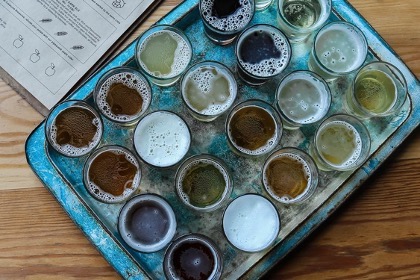Special Feature: Products Sally Recommends
what you need to make your own brews
Homebrewing has become a recent favorite pastime in households worldwide. It's a fun and creative way to spend your free time, and you get a delicious treat as a result!
However, you can't make beer and cider from scratch. You'll want to learn each step of the process, but you'll also need to get stocked up on the right equipment.
Here's what you need to kickstart your first homebrew.
Before You Begin
You will need to get started a few essentials to begin:
- Stockpot. Roughly 3 gallons of water is the perfect size to produce a 1-gallon batch.
- Long mixing stick. It should be long enough to reach the very bottom of your stockpot.
- Strainer or a colander. You'll be using this to separate the grains during brewing.
- Kitchen scale.
- Instant thermometer a digital timer. However, your phone alarm will also work just fine.
- Beer labels. Designing your own beer brand is one of the most fun and rewarding aspects of home brewing. You can get started on your design before your first batch is done with Grogtag customized beer labels.

The Fermentation Process
The equipment necessary for fermenting is more involved. Let's breakdown what you use each item for so you know exactly what to do when it comes time to brew.
- A large food-grade plastic bucket with a tight-fitting holed lid. This will serve as your primary fermenter for the beginning stages of the brewing. It's important the lid is tight and that the hole will fit the airlock you'll need to buy.
- An Airlock. This allows gases to escape from your fermentation bucket but doesn't let anything get in, keeping your brewing safe from bad bacteria. It's important to know how the airlock you have works, so take a minute to learn about your equipment with the manual.
- A gallon jug with a hole and stopper. This is going to act as your secondary fermenter for the less active stage of the brewing process. Clear jugs are fine. However, green glass has been shown to protect against UV rays. Make sure the stopper fits tight into your jug.
- An auto-siphon. This is what you'll be using to transfer your brew between the bucket and the jug, as well as when you get to bottling the beer. Make sure you have the right size for your bucket and jug. Additionally, you'll require plastic tubing and clamps that fit tightly over your auto-siphon to avoid any spillages.
- Sanitizer. Keeping your equipment clean is the most important part of the process. With the bacteria that builds during the fermentation process, it's vital not to pollute your next batch with the leftovers.
Between Fermentation and Bottling
There is one thing needed for the process between fermentation and bottling your homebrew. A Hydrometer calculates the alcohol percentage of your finished product after the brewing is done!
When purchasing this piece of equipment, it's worth checking whether it comes with tubing or not. The tubing holds the brew and uses gravity to check the alcoholic content of the beer.
Bottling
All that's really needed for bottling are a few simple things!
- Bottles and Caps: without something to pour your finished product into and keep it sealed, all your hard work is just going to spoil.
- Bottle Filler: You don't want your beer going all over the floor. This simply keeps the beer flowing into where it's meant to be.
- Bottle Capper: Slip a cap in, fix it to the top of your bottles and simply clamp it down to secure your brew.
Conclusion
We recommend getting everything mentioned in this guide if you want to do it right, from stockpot to sanitizer. With this equipment, as well as some malt and yeasts, you're more than ready to get started!
Once you stock up on these supplies, you'll be ready to follow a step-by-step guide and brew your first batch!
Note: This information was accurate when it was published. Please be sure to confirm all rates and details directly with the businesses in question before making your plans.



